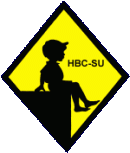
The boys seen here look to be wearing light-weight summer suits whivch we believe is their school uniform. It is a family snapshot prined in postcard format. It was s postally used in Monmouth, Wales during 1908. It illustrates what affluent middle class boys would have been wearing in the summer of that year. The writing on the back of the card
states that the boys were visiting their uncles military camp--which explains the wagon behind them. RFA stands for Royal Field Artillery. The handwriting on the back of the card is very difficult to read but it appears to say, "This shows Walter & Morris and two other boys ( Something & Duckworth) at Uncle Cliffords Camp this year." The card is addressed to Harold Phillips, Clifton House, High Street, Sandown, Isle of Wight. HBC believes that the two standing boys are the brothers Walter & Morris and the two sitting boys are their friends. The fact that they are dressed alike suggests that they were school mates and this was their scchool uniform. Spending the summer with schoolmates was a common matter in the late 19th and eery 20th centuries. There is even an film about it--The Go Between (England, 1971).
Wales is of course one of the constituent countries of the United Kingdom . Historically, the English were much more successfull in exstinuigishing Welsh independence than was the case in either Scotland and Ireland (Scotland and Ulster). HBC has archieved separate information on other parts of the U.K. We have not done this for Wales, primarily because we have not noted any destinctive styles from English styles.
An examination of the boys outfits, provide a numbr of insights into English school uniforms in the 1900s.
Caps: The traditional peaked cap was widely worn in the 1900s, both at private and state schools. Note that there is no badge on the caps the boys are wearing here.
Suits: Private school boys in the 1900s generally wore suits. Some schools had inter and summer suits. Note that the suits here do not have bad a school badge or shield. The older boy has a four buttin suit and the younger boy a three-button suit. All the buttons are buttoned. These boys probably also had blazers, but they were worn for sport. The boys at the school wore both long trousers and knee pants. I'm not sure if a school rule was envolved here, or if it was a matter left to the parents, but it probbly was tyhe iunger boys who wore knee pantrs..
Collars: The school these boys attended appears to have required Eton collars for the younger boys and soft collars for the older boys. The school also appars to have required neckties, although one boy here does not wear them.
Hosiery: The boys at the school with knee pants wore long dark stockings.
An English reader is not convinced that the boys are wearing their school uniforms. He writes, "It's just at likely that their parents outfitted the boys through one of the department store catalogues which were becoming popular at the time. There are pages of suits like these. Which isn't to say that they did not wear these outfits to school: but it would not have been school uniform as we understand it now--rigorously specified down to the colour of the socks." Here HBC does not agree. "If these boys were all brothers, I would be attemoted go along with the possibility that mother was dressing them alike from the same catalog or outfitter. But only two of these boys are brothers. The other two were friends from school. So we have boys from three different families. We thus believe it virtually impossible that three mohers/fathers would have chosen idetical caps, ties, and suits. Note that not only is the style the same, but also the color. Also note that the kneepants and long pants are the same material and color. This is much mor likely be th case for a school unifrm than suits in catalogs and or shops.
Related Chronolgy Pages in the Boys' Historical Web Site
[Main Chronology Page]
[The 1880s]
[The 1930s]
[The 1940s]
[The 1950s]
[The 1960s]
[The 1970s]
[The 1980s]
Navigate the HBC English School Cronology Pages:
[Return to the Main 1900s private school page]
[Main English 20th century page]
[Main early 20th century page]
[Inter-war years]
[Post-war years]
[Late 20th century]
Navigate the HBC School Section:
[Return to the English school pages]
[Return to the Main country school page]
[Australia]
[France]
[Germany]
[Italy]
[Japan]
[New Zealand]
[Scotland]
[United States]
Navigate the HBC School Section:
[About Us]
[Activities]
[Chronology]
[Clothing styles]
[Countries]
[Debate]
[Economics]
[Garment]
[Gender]
[Hair]
[History]
[Home trends]
[Literary characters]
[School types]
[Significance]
[Transport and travel
[Uniform regulations]
[Year level]
[Other topics]
[Images]
[Links]
[Registration]
[Tools]
[Return to the Historic Boys' School Home]
